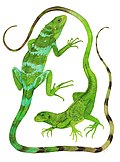Ctenosaura hemilopha
| Cape Spinytail Iguana[1] | |
|---|---|

| |
| Scientific classification | |
| Kingdom: | |
| Phylum: | |
| Class: | |
| Order: | |
| Family: | |
| Genus: | |
| Species: | C. hemilopha
|
| Binomial name | |
| Ctenosaura hemilopha Cope, 1863
| |
| Synonyms | |
|
Cyclura hemilopha , Ctenosaura insulana | |
Ctenosaura hemilopha, also known as the Cape Spinytail Iguana , is a species of spinytail iguana endemic to Baja California.[2] It is arboreal and primarily herbivorous, although it can be an opportunistic carnivore. Males may grow up to 100 centimeters (39 in) in length, while females are smaller, with a length of up to 70 centimeters (28 in). There are five subspecies currently recognized.
The existence of mainland and insular populations of this species has been valuable in providing biologists with study and control groups comparing the evolution of island populations and their mainland counterparts. The San Esteban Island subspecies (C.h. conspicuosa) coexists with the giant San Esteban Chuckwalla, contrary to predictions of ecological niche theory.
Taxonomy and etymology
Ctenosaura hemilopha was first described by zoologist Edward Drinker Cope in 1863.[3] The generic name, Ctenosaura, is derived from two Greek words: cteno (Κτενός), meaning "comb" (referring to the comblike spines on the lizard's back and tail), and saura (σαύρα), meaning "lizard".[4] Its specific name is a combination of the Greek word hemisus (ήμισυς) meaning "half" and lophos (λοφος) meaning "crest" or "plume" ; both are in reference to the animal's short crest of spines, when compared to other species of its genus.
There are five subspecies of C. hemilopha that are all similar in appearance and habitat.[5]
- C. h. hemilopha occurs on the southern half of the Baja California peninsula, Mexico.[5]
- C. h. conspicuosa is found on San Esteban Island (Isla San Esteban) and Cholludo Island (Isla Cholludo) in the Gulf of California.[5]
- C. h. insulana is found on Cerralvo Island (Isla Cerralvo) 5 miles off the southern part of Baja near La Paz, Baja California Sur.[5]
- C. h. macrolopha is found on the Mexican mainland from Hermosillo, Sonora, south to mid Sinaloa.[5]
- C. h. nolascensis is found on San Pedro Nolasco Island (Isla San Pedro Nolasco).[5]
Distribution and habitat
It is believed that these iguanas may have ended up on the Baja peninsula and the islands because early Seri Indian inhabitants transported them there from the mainland as food sources thousands of years ago.[6][2] This theory is based on the fact that the coastal distribution on the mainland ends 115km south of Isla San Esteban.[6][2] Contrary to predictions from ecological niche theory, the species coexists with the giant San Esteban Chuckwalla on San Esteban Island.[6] The two species forage for the same plants in the same habitat at the same time of day during the same season, with neither species displacing the other.[6][2]
The Cape Spinytail iguana makes its den in old woodpecker nests in giant columnar cacti, and in other tree cavities.[7] The most important factors determining the choice of cactus are the existence of other holes, and the cactus height because these types of refuges allow the lizards to feed and bask on the tree, minimizing the risk of predation.[7]
The existence of mainland and insular populations of this species has been valuable in providing biologists with study and control groups comparing the evolution of island populations.[8]
Description
The Cape Spinytail iguana has a green or yellow coloring when young and turns whitish gray with age. As this animal matures it can be white or light gray in color with black chevrons, depending on heat conditions or even the animal's temper.[4]
Males achieve a maximum length of 100 centimeters (39 in), while females are typically 30% smaller at 70 centimeters (28 in). Males develop large jowls and a dorsal crest made up of larger dorsal spines, making the animal sexually dimorphic.[2]
Diet
Like most iguanids, the Cape Spinytail iguana is primarily herbivorous, eating flowers, leaves, stems, fruit, and cactus such as the bushy Jatropha cuneata and the taller, spindly Solanum hindsianum.[9] They will opportunistically eat smaller animals, eggs, and arthropods.[4]
References
- ^ "Ctenosaura hemilopha". Integrated Taxonomic Information System. 30 September.
{{cite web}}: Check date values in:|date=and|year=/|date=mismatch (help) - ^ a b c d e Grismer, L. Lee.(2002) Amphibians and Reptiles of Baja California, Including Its Pacific Islands and the Islands in the Sea of Cortés. The University of California Press.409 p. ISBN: 0520224175
- ^ Cope, E.D. (1864). Descriptions of new American Squamata in the Museum of the Smtihsonian Institution. Proceedings of the Acadamey of Natural Science. Philadelphia. 15 1863: 100–106
- ^ a b c Malfatti, Mark (2007). "A Look at the Genus Ctenosaura: Meet the World's fastest lizard and its kin". Reptiles Magazine. 15 (11): 64–73.
- ^ a b c d e f Malfatti, Mark (2005). "Baja / Sonoran Spiny-tailed Iguanas". West Coast Iguana Research. Retrieved 30 September 2008.
- ^ a b c d Nabhan, Gary (2003). Singing the Turtles to Sea: The Comcáac (Seri) Art and Science of Reptiles. University of California Press. p. 350. ISBN 0520217314.
- ^ a b Blázquez, Carmen (2001). "Winter refuge characteristics of Spiny-tailed iguanas, Ctenosaura hemilopha, in Baja California Sur, Mexico". Journal of Arid Environments. 49 (3): 593–599.
{{cite journal}}:|access-date=requires|url=(help); Unknown parameter|coauthors=ignored (|author=suggested) (help) - ^ Blazquez M. C., Rodriguez-Estrella R., Delibes M (1997) "Escape behavior and predation risk of mainland and island spiny-tailed iguanas (Ctenosaura hemilopha)" Ethology 103(12): 990–998
- ^ Carothers, John H. (1983). "Size-related activity patterns in an herbivorous lizard". Oecologia (Berlin). 57 (1–2). Museum of Vertebrate Zoology and Department of Zoology, University of California, Berkeley: 103–106.
{{cite journal}}:|access-date=requires|url=(help)


